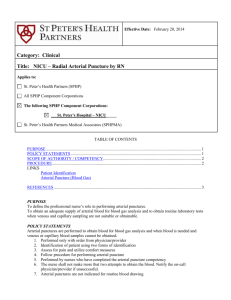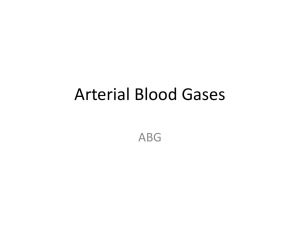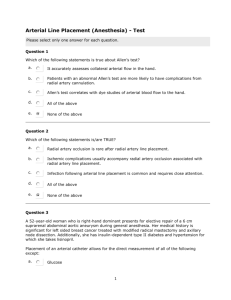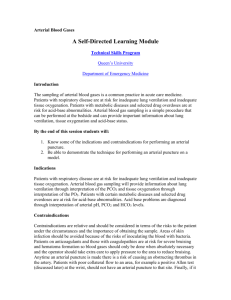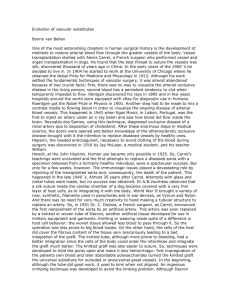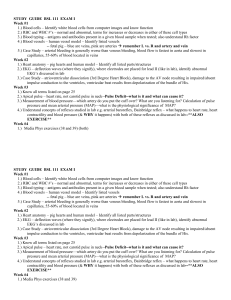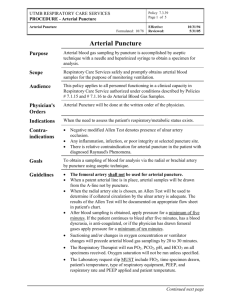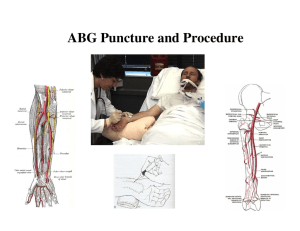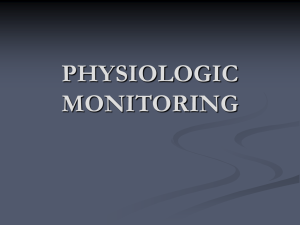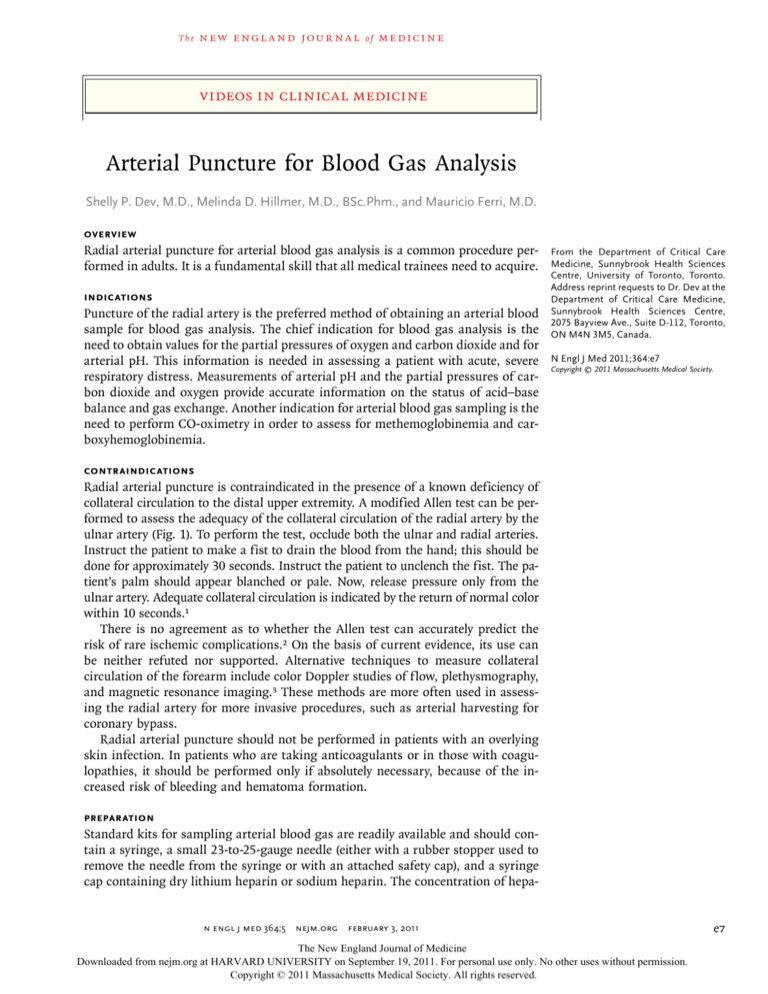
The
n e w e ng l a n d j o u r na l
of
m e dic i n e
videos in clinical medicine
Arterial Puncture for Blood Gas Analysis
Shelly P. Dev, M.D., Melinda D. Hillmer, M.D., BSc.Phm., and Mauricio Ferri, M.D.
Overview
Radial arterial puncture for arterial blood gas analysis is a common procedure performed in adults. It is a fundamental skill that all medical trainees need to acquire.
Indications
Puncture of the radial artery is the preferred method of obtaining an arterial blood
sample for blood gas analysis. The chief indication for blood gas analysis is the
need to obtain values for the partial pressures of oxygen and carbon dioxide and for
arterial pH. This information is needed in assessing a patient with acute, severe
respiratory distress. Measurements of arterial pH and the partial pressures of carbon dioxide and oxygen provide accurate information on the status of acid–base
balance and gas exchange. Another indication for arterial blood gas sampling is the
need to perform CO-oximetry in order to assess for methemoglobinemia and carboxyhemoglobinemia.
From the Department of Critical Care
Medicine, Sunnybrook Health Sciences
Centre, University of Toronto, Toronto.
Address reprint requests to Dr. Dev at the
Department of Critical Care Medicine,
Sunnybrook Health Sciences Centre,
2075 Bayview Ave., Suite D-112, Toronto,
ON M4N 3M5, Canada.
N Engl J Med 2011;364:e7
Copyright © 2011 Massachusetts Medical Society.
Contraindications
Radial arterial puncture is contraindicated in the presence of a known deficiency of
collateral circulation to the distal upper extremity. A modified Allen test can be performed to assess the adequacy of the collateral circulation of the radial artery by the
ulnar artery (Fig. 1). To perform the test, occlude both the ulnar and radial arteries.
Instruct the patient to make a fist to drain the blood from the hand; this should be
done for approximately 30 seconds. Instruct the patient to unclench the fist. The patient’s palm should appear blanched or pale. Now, release pressure only from the
ulnar artery. Adequate collateral circulation is indicated by the return of normal color
within 10 seconds.1
There is no agreement as to whether the Allen test can accurately predict the
risk of rare ischemic complications.2 On the basis of current evidence, its use can
be neither refuted nor supported. Alternative techniques to measure collateral
circulation of the forearm include color Doppler studies of flow, plethysmography,
and magnetic resonance imaging.3 These methods are more often used in assessing the radial artery for more invasive procedures, such as arterial harvesting for
coronary bypass.
Radial arterial puncture should not be performed in patients with an overlying
skin infection. In patients who are taking anticoagulants or in those with coagulopathies, it should be performed only if absolutely necessary, because of the increased risk of bleeding and hematoma formation.
Preparation
Standard kits for sampling arterial blood gas are readily available and should contain a syringe, a small 23-to-25-gauge needle (either with a rubber stopper used to
remove the needle from the syringe or with an attached safety cap), and a syringe
cap containing dry lithium heparin or sodium heparin. The concentration of hepa-
n engl j med 364;5 nejm.org february 3, 2011
The New England Journal of Medicine
Downloaded from nejm.org at HARVARD UNIVERSITY on September 19, 2011. For personal use only. No other uses without permission.
Copyright © 2011 Massachusetts Medical Society. All rights reserved.
e7
The new england journal of medicine
Figure 1. Location of the Radial and
Ulnar Arteries.
rin varies depending on the manufacturer of the kit. Alcohol swabs, gauze, tape,
nonsterile gloves, and a nonsterile gown are also needed. A solution of 1% lidocaine
without epinephrine can be used for local analgesia. Lidocaine can be drawn up in
a 5-cc syringe and administered through a small 25-gauge needle. A rolled towel is
helpful in positioning the wrist. A bag of ice may be required by the laboratory for
transporting the arterial sample.
Arterial blood gas sampling often takes place in an emergency setting and may
not allow for consent to be obtained from the patient or next of kin. When possible, the procedure should be explained to the patient and consent obtained.
Locating Landmarks
Before examining the patient, wash your hands in accordance with good hygienic
standards. Extend the patient’s wrist to bring the radial artery to a more superficial
position. First, palpate the styloid process of the radius. Next, palpate the flexor
carpi radialis tendon located medial to the styloid process of the radius. The radial
artery is located between the styloid process of the radius and the flexor carpi radialis tendon (Fig. 2).
The artery may be difficult to palpate in some patients, such as when there is
overlying edema or vasospasm. In these instances, a portable Doppler ultrasound
device may be used to identify the location of the radial artery.
Figure 2. Location of the Flexor Carpi
Radialis Tendon, the Radial Artery,
and the Styloid Process of the Radius.
The radial artery is located between
the tendon and the styloid process.
Figure 3. Puncture of the Radial
Artery.
Procedure
The patient’s wrist should be extended in the supine position to bring the radial
artery to a more superficial position. A rolled towel can be placed under the wrist
to maintain this position. Once the wrist is positioned, put on nonsterile gloves and
a nonsterile gown. Open the sampling kit and identify all the components so they
are ready for use. Clean the site with an alcohol swab. Palpate the radial pulse and
determine the point of maximum impulse, or use the Doppler ultrasound device to
identify the location of the radial artery.
Using the 5-cc syringe and small needle, load the syringe with 1% lidocaine.
When first inserting the needle under the skin, pull back on the plunger to ensure
that you have not punctured a vessel. Inject a small wheal of analgesic around the
artery and wait 30 to 60 seconds for the lidocaine to take effect. Relocate the
maximum impulse with the index and middle fingers of your nondominant hand.
Holding the arterial blood gas syringe with your dominant hand, aim the
needle away from the patient’s hand toward the upper arm. Puncture the skin at
a 30-to-45-degree angle at a point just below the index and middle fingers of your
nondominant hand. Advance the needle slowly until the syringe easily and passively fills with bright red, pulsating blood (Fig. 3). Ideally, you should obtain at
least 1 to 2 cc of blood. If no blood is obtained, do not pull back on the plunger;
instead, withdraw the needle slowly until it is just under the skin and reattempt
the procedure.
After the blood sample is collected, withdraw the syringe and apply pressure to
the site with sterile gauze for approximately 5 minutes. In the meantime, expel the
air bubbles from the syringe. Cover the needle with the attached safety cap and
remove the needle from the syringe, or use the rubber stopper to remove the
needle from the syringe. Attach the heparin-containing cap and, while holding
the cap in place, push the plunger of the syringe to ensure the blood encounters
the heparin. This will prevent the blood from clotting. Make sure that the syringe
is labeled with the patient’s name and unit number. If transport to the laboratory
is required, place the entire syringe in the bag of ice.
Once pressure has been applied to the puncture site for 5 minutes, affix the
gauze with some tape. Dispose of all sharps in designated sharps containers.
n engl j med 364;5 nejm.org february 3, 2011
The New England Journal of Medicine
Downloaded from nejm.org at HARVARD UNIVERSITY on September 19, 2011. For personal use only. No other uses without permission.
Copyright © 2011 Massachusetts Medical Society. All rights reserved.
Arterial Puncture for Blood Gas Analysis
Complications
The most common technical difficulties associated with radial arterial puncture for
arterial blood gas analysis are the failure to obtain a blood sample because of vasospasm and the collection of venous blood instead of arterial blood. If vasospasm is
suspected, abort the procedure and reattempt it on the other wrist. A blood sample
is likely to be venous if it is nonpulsatile and dark in color and flows slowly. It
should be noted, however, that extremely deoxygenated blood in a patient with
hypoxemia could also appear dark, even though it is arterial.
Serious vascular complications, such as radial arterial aneurysm, hand ische­
mia, and hematoma causing compartment syndrome, are rare but have been described in case reports.4
Summary
Arterial blood gas analysis provides useful information regarding respiratory and
metabolic pathology. The partial pressure of carbon dioxide, bicarbonate concentrations, and pH values indicates the presence or absence of primary or mixed respiratory and metabolic acidoses or alkaloses. The partial pressure of oxygen will
reveal abnormalities in the oxygen content of blood and the presence or absence of
hypoxemia. With the appropriate technique, radial arterial puncture for arterial
blood gas analysis is a skill easily mastered by medical trainees. A more detailed
approach to the diagnosis of acid–base disorders and hypoxemic respiratory failure,
while necessary, is beyond the scope of this instructional video.
References
1. Ruengsakulrach P, Brooks M, Hare
DL, Gordon I, Buxton BF. Preoperative assessment of hand circulation by means of
Doppler ultrasonography and the modified Allen test. J Thorac Cardiovasc Surg
2001;121:526-31.
2. Barone JE, Madlinger RV. Should an
Allen test be performed before radial artery cannulation? J Trauma 2006;61:46870.
3. Agrifoglio M, Dainese L, Pasotti S, et
al. Preoperative assessment of the radial
artery for coronary artery bypass grafting: is the clinical Allen test adequate?
Ann Thorac Surg 2005;79:570-2.
4. Halpern AA, Mochizuki R, Long CE
III. Compartment syndrome of the forearm following radial-artery puncture in
a patient treated with anticoagulants.
J Bone Joint Surg Am 1978;60:1136-7.
Copyright © 2011 Massachusetts Medical Society.
Disclosure forms provided by the authors are available with the full text of this article at NEJM.org.
n engl j med 364;5 nejm.org february 3, 2011
The New England Journal of Medicine
Downloaded from nejm.org at HARVARD UNIVERSITY on September 19, 2011. For personal use only. No other uses without permission.
Copyright © 2011 Massachusetts Medical Society. All rights reserved.

